Hisense H55O8BUK Review
Hisense H55O8BUK Review
This 4K OLED TV promises premium performance without the price-tag
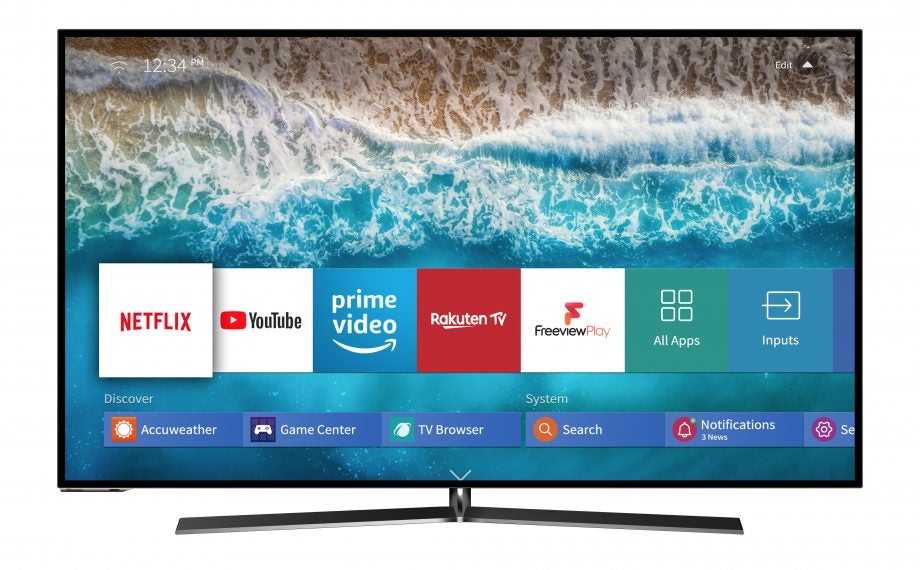
Verdict
This competitively priced 4K OLED TV delivers impressive SDR and HDR images, a simple but effective smart platform, and solid audio performance that includes Dolby Atmos. In fact only HDR10+ support is missing from an otherwise strong first effort.
Pros
- Impressive picture quality
- Great blacks and contrast
- Simple but effective smart platform
- Dolby Vision and Atmos
- Competitively priced
Cons
- Limited HDR brightness
- No HDR10+ support
Key Specifications
- Review Price: £1499
- 4K Ultra HD resolution
- HDR: HDR10, Dolby Vision and HLG
- VIDAA U
- 4 x HDMI 2.0
The Hisense O8B 4K OLED TV represents the company’s first foray into self-emissive displays and, like every other manufacturer, it uses a panel made by LG. The OLED market is becoming congested with the likes of Panasonic, Sony, Philips, and LG itself all offering OLED TVs in various sizes, all based on the same basic panel.
Since the panels are essentially identical, all these competing models are differentiated by other factors, such as cosmetic design, user interface, special features, picture processing and, of course, cost. Hisense certainly has the latter covered with some very competitive retail pricing, but how does the O8B measure up in other areas?
At first glance, Hisense doesn’t appear to have cut too many corners to hit a lower price point. The O8B offers everything you’d expect from a modern TV, with a slimline design, support for 4K Ultra HD and HDR (including Dolby Vision), the VIDAA U smart platform, and even Dolby Atmos. If its performance is as good as its feature set, the O8B could be a real bargain.
Hisense currently offers a single 55-inch model (H55O8BUK) with a retail price of £1499.
Related: Best TVs
Design — The Hisense O8B sports the kind of super-slim and elegant look we’ve come to expect from OLED TVs
The Hisense O8B boasts the kind of super-slim looks you’d expect from an OLED TV, with an appearance that mirrors most of the other models based on an LG panel. The screen itself is mere millimetres thick at the top, although the bottom third widens out to 58.5mm where the electronics, connections and speakers are housed.

There’s an elegant simplicity to the design, with a near bezelless frame and minimalist black finish. Despite the slimline chassis, the metal construction adds rigidity and the black metal V-shaped stand provides solid support. The rear of the panel is also finished in black metal and here you’ll find VESA brackets for wall mounting the unit.
The connections are also located at the rear, behind a removable panel on the left-hand side of the TV as you face the screen. Here you’ll find four HDMI 2.0b inputs with support for 4K/60p, HDR (HDR10, HLG, and Dolby Vision), and HDCP 2.2. One of the HDMI inputs also includes ARC (audio return channel), but there’s no support for the enhanced version (eARC).
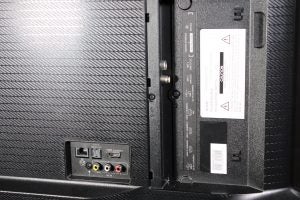
Other connections include two USB 2.0 ports, terrestrial and satellite tuners, a LAN port, CI slot, an optical digital output, analogue stereo input, and a composite video input. In terms of wireless support there’s built-in Wi-Fi (dual band 802.11ac), and Bluetooth.
The O8B comes with two remotes: a black plastic version and a flashier black and silver metal controller. Quite why Hisense includes two remotes is a mystery because these essentially mirror each other in terms of key layout, so why would you use the plain black one when the flash metal option is available?
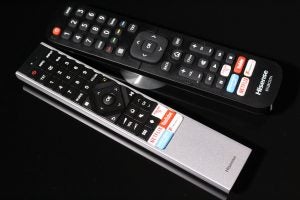
Whichever version you choose, they both have all the buttons you’ll need to control the TV, including direct access keys for Netflix, Amazon Prime, YouTube, Rakuten TV, and Freeview Play. The remotes also include built-in microphones for voice control, and Hisense plans to add this feature with a future firmware update. If two remotes and your voice aren’t enough, there’s a simple but effective control app called RemoteNow (available for iOS and Android) that mirrors the TV’s smart system.
Related: Best budget TVs
Features — No AI processing, but the Hisense O8B does have Dolby Vision and a dedicated game mode
The Hisense O8B uses a 55-inch 4K Ultra HD (3840 x 2160) 10-bit panel that accepts a 12-bit signal, supports 4K frame rates up to 120Hz, and offers very wide viewing angles. In testing, the panel reproduced 96% of the DCI-P3 wider colour gamut and delivered a peak brightness of 610 nits on a 10% window – which is about average for an OLED TV.
The O8B lacks the kind of AI-enhanced processing found on many of its competitors. Instead, Hisense keeps things simple with a standard quad-core processor. However, the TV includes a media player and is able to decode all the main video formats, as well as upscale lower resolution content to 4K.
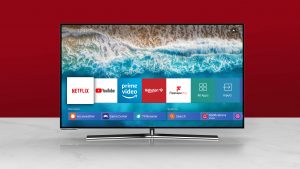
The Hisense supports HDR, specifically HDR10, broadcast hybrid log-gamma (HLG), and Dolby Vision. However it doesn’t support HDR10+, which is an open-source version of HDR that uses dynamic metadata in a similar fashion to Dolby Vision. This is surprising given that Hisense was an early supporter of HDR10+, and puts the O8B at a disadvantage to competing OLEDs from Panasonic and Philips, which support both formats.
The O8B includes Hisense’s Ultra Smooth Motion, which is a frame interpolation feature that’s handy for watching fast-paced sports broadcasts. The Hisense also includes the Sports Mode Auto detection feature, which enables the TV to detect a sports broadcast on its internal tuner and offer you the option of selecting the Sports mode.
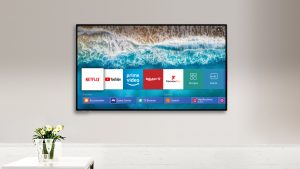
There’s a dedicated Game mode setting, which bypasses much of the processing and delivers an input lag of 24ms. That should be low enough for even the most demanding gamer, and it applies whether you’re gaming in 1080p, 4K, SDR or HDR. If you’re a competitive gamer you should definitely use the Game mode because otherwise the lag jumps up to 50ms.
Related: Netflix vs Amazon Video
Smart platform — The Hisense O8B smart interface is a simple and sensible affair
The Hisense O8B uses the latest version of the company’s VIDAA U smart operating system, which, while not as groundbreaking as LG’s webOS platform, is effective in operation. Hisense has taken the sensible approach of keeping things relatively simple, and concentrating on the features that users actually need, such as video streaming services.
The latest iteration of VIDAA U has a redesigned home page that you access by pressing the Home button on the remote. This displays a series of tiles about a third of the way up from the bottom of the screen, and you simply scroll through and select the app you want. You can add apps from the store and edit the layout so the most commonly used apps appear first.
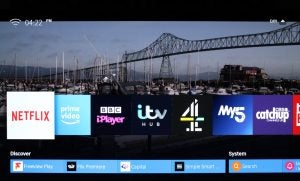
The system overlays these tiles onto the picture and is slick and responsive thanks to the quad-core processing. At the bottom of the screen is the Discover bar, which suggests other apps, along with the System bar that provides access to notifications, a search function, and all the menus. There’s also a side-menu button that offers quick access to the settings menus.
As well as the home page, you can also directly access Netflix, Amazon Prime, YouTube, Rakuten TV, and Freeview Play using dedicated buttons on the remotes, with Netflix, Amazon Prime and YouTube all supporting 4K, HDR, and Dolby Vision where available. There’s also Freeview Play, which provides access to all the UK catch-up services, with the BBC iPlayer app supporting 4K and HLG. It’s a decent selection of video streaming apps, with only Now TV and Apple TV missing (although the latter is currently exclusive to Samsung).
Related: What is Freeview Play?
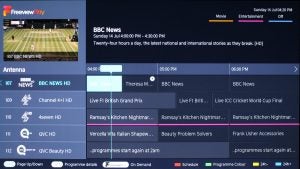
The TV includes an EPG (electronic programme guide), which you can also access directly from the remote control. There’s a picture-in-picture of the channel you’re currently on, and the guide displays five channels across a three-hour period. Thanks to Freeview Play, you can also move backwards and watch programmes you missed using the UK catch-up and on-demand services.
If you attach a hard drive you can turn the TV into a PVR (personal video recorder), thus allowing you to time shift by recording programmes. However there’s only one tuner each for both terrestrial and satellite TV, so you can’t watch one channel and record another.
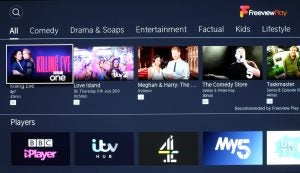
The smart platform includes a web browser and it supports DLNA, allowing you to access content on your home network. There’s also a media player, and the O8B decodes a wide range of files including HEVC (H.265), VP9, H.264, MPEG4, MPEG2, VC1, and MVC.
Related: Best streaming sites
Picture performance — The Hisense O8B puts in an impressive picture performance
The Hisense O8B delivers an impressive picture performance, proving the Chinese TV giant is capable of competing with the established players. Granted, the O8B is based on the same LG panel used by all the other manufacturers, but Hisense avoids any obvious pitfalls to deliver a solid first effort that takes full advantage of OLED’s inherent strengths.
As a result, the black levels are pleasingly deep and the shadows are free of any obvious crush, while the self-emissive nature of OLED ensures the brighter parts of the image are delivered without the blooming that often plagues LCD TVs. The latter also struggle when it comes to viewing angles, but on the O8B these are incredibly wide, ensuring everyone sees the optimal picture.

The colour performance is equally as impressive, and watching a Blu-ray like Samsara reveals wonderfully natural and accurate images. The colours are equally as impressive with HDR content, allowing the panel to fully utilise its wider colour gamut. As a result, a highly saturated 4K Blu-ray like Guardians of the Galaxy Vol. 2 looks incredibly saturated but also naturally nuanced.
The processing is also very good, and while not as flashy as the AI-enhanced wizardry employed by some manufacturers, it does the basics well. This ensures that lower-resolution images are effectively upscaled to match the Ultra HD panel without introducing unwanted artefacts. When receiving a 4K image the performance is just as impressive, with plenty of well-defined detail.
The native motion handling is reasonable and basically what would be expected of an OLED panel, appearing free of excessive judder. However, if you feel it needs improving, the Ultra Smooth Motion feature offers a number of options and uses frame interpolation to smooth out moving images. This works well with sports, but is best avoided with films and TV dramas.

The O8B really impresses with HDR content because although OLED isn’t as bright as LCD overall, it can deliver small highlights with exacting precision. When you combine this with the deep blacks and superior shadow detail, the result is an image with remarkable dynamic range. This combination of contrast and pixel-precise highlights ensures HDR that has plenty of impact.
This impressive HDR performance is aided by excellent tone mapping that proves extremely accurate in testing, and ensures that HDR10 content is displayed without unnecessary compromise or unwanted manipulation. The O8B also supports Dolby Vision, which uses dynamic metadata to deliver subtle improvements in the HDR performance.
Dolby Vision is available on Netflix, Amazon Prime, Apple TV, and 4K Ultra HD Blu-ray; watching the Dolby Vision presentation of Alita: Battle Angel on the latter is a revelation, with incredibly detailed images that burst with colours and contrast. The same is true of Altered Carbon on Netflix, with wonderful Dolby Vision images that reveal every shadowy corner of the show’s dark and gritty sci-fi urban streets.
Related: Best TV deals
Audio performance — When it comes to sound, the Hisense O8B puts in a solid performance
The Hisense O8B delivers a solid audio performance considering its ultra-slim chassis and downward-firing stereo speakers. These are powered by 10W for each channel, which is fine for basic TV viewing but clearly can’t compete with larger TVs and soundbars. The audio also lacks the AI-enhanced wizardry that’s now being employed by the likes of LG and Samsung.
However the O8B manages to create a wide front soundstage that retains some nice detail and a degree of clarity. The dialogue is clear and focused, while music spreads out from either side. Effects sound clear and precise, but unsurprisingly there’s very little in the way of real bass. Hisense offers a number of sound modes: Standard, Speech, Late Night, Music, Theatre (for movies), and Sports.
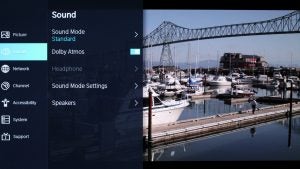
The O8B is the first Hisense TV that supports Dolby Atmos, allowing it to decode the discrete channels encoded in Atmos content and create a more immersive experience. Obviously it can’t fully replicate a genuine multichannel speaker setup but the use of psychoacoustics results in a more open sound, with a greater sense of envelopment. This feature worked when watching discs that included a Dolby Atmos soundtrack, but Hisense has yet to update the Netflix and Amazon Prime apps to also support Atmos (this is in the works).
Related: Best soundbars
Hisense O8B – Settings
The Hisense O8B has a number of different picture modes, including Standard, Cinema Day, Cinema Night, Dynamic and Sports. The TV ships in the Standard mode and while many users will be perfectly happy with that choice, it does result in an image that’s too bright, is overly saturated, has bluey whites and suffers from an excess of image processing.
If you like to watch content as the director intended, select either of the Cinema modes to get you closest to the industry standards. You can use Cinema Day for viewing when there’s a lot of ambient light in the room, and Cinema Night for when the room is darker. Hisense includes a Gamma setting, and here the best choice is 2.2 for the Day mode, and 2.4 for Night.

There are a number of calibration controls included, but given the price point it’s unlikely many owners will stump up for the cost of a professional calibration. However, as long as you select the correct mode from the start, the out-of-the-box performance is reasonably accurate with both SDR and HDR content.
In terms of the latter, you have a choice of Dynamic, Day, Night, and Sport for HDR10 content, and Bright or Dark for Dolby Vision content. The HDR Night and Dolby Vision Dark settings deliver the most accurate performance, but if you feel the image requires a boost, then try HDR Day and Dolby Vision Bright.
At Dolby’s insistence the Bright and Dark settings can’t be adjusted, but there are calibration controls for the HDR10 modes. When first setting up the O8B, don’t forget to go into the HDMI & CEC Function part of the System submenu and ensure you have selected HDMI 2.0 Enhanced Format for any HDMI input connected to an HDR source.
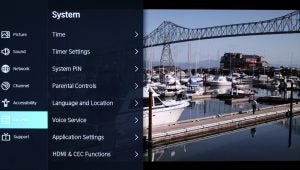
The O8B automatically detects an incoming 4K signal and defaults to the correct aspect ratio, but it’s best to turn Ultra Smooth Motion off when watching movies or TV dramas. If you don’t, they may end up looking like cheap video, but the mode can be quite useful when watching fast-paced sporting action.
If you’re planning on gaming, just select your preferred picture mode and turn on Game mode. This will bypass all the unnecessary video processing, ensuring the lowest input lag for gamers who prize their cat-like reactions. Finally, the O8B is able to detect a static image and bring up a screensaver, which will help protect the OLED from any potential image retention.
Related: What is HDR?
Should I buy the Hisense O8B?
The Hisense O8B is a strong first effort from the Chinese manufacturer, offering all the benefits of a new 4K OLED TV but at a considerably lower price point. This ultra-slim model sports an attractive design and an excellent level of build quality, along with a decent set of connections and a brace of remote controls.
The VIDAA U smart platform has been updated and while it remains relatively simple, it includes the majority of catch-up and on-demand services. The O8B doesn’t include any AI enhancements, nor does it work with Alexa or Google, but you have to wonder how appealing the latter is to most people.
The O8B certainly delivers the goods where it counts, producing bright and punchy 4K images that boast plenty of detail. The HDR performance is very impressive and even includes support for Dolby Vision. The lack of HDR10+ is surprising given Hisense was an early supporter, but the addition of Dolby Atmos helps boost the audio performance.
As far as the competition is concerned the obvious alternatives are the LG B9 and the Panasonic GZ950, both of which retail for £1799. The LG includes a similar feature set to the Hisense, but adds the awesome webOS smart platform, AI-enhanced processing, and HDMI 2.1 inputs. The Panasonic has similar specs, but boasts the company’s justifiably famous image accuracy and includes HDR10+ support along with Dolby Vision. Whether you think these alternatives are worth the extra £300 is debatable, and at its current price the Hisense O8B is hard to fault.
How we test televisions
We test every TV we review thoroughly over an extended period of time. We use industry standard tests to compare features properly. We’ll always tell you what we find. We never, ever, accept money to review a product.


